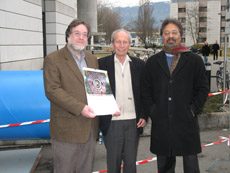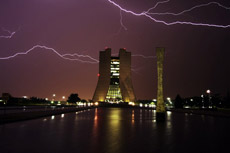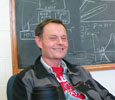|
Wednesday, July 16
3:30 p.m.
DIRECTOR'S COFFEE BREAK - 2nd Flr X-Over
THERE WILL BE NO FERMILAB COLLOQUIUM THIS WEEK
Thursday, July 17
1 p.m.
Physics and Detector Seminar - West Wing, WH-10NW
Speaker: M. Palmer, Cornell University
Title: ILC Damping Rings
2:30 p.m.
Theoretical Physics Seminar - Curia II
Speaker: G. Mahlon, Pennsylvania State University, Mont Alto
Title: Relations Among Spin Amplitudes for 2-->2 Scattering
3:30 p.m.
DIRECTOR'S COFFEE BREAK - 2nd Flr X-Over
4 p.m.
Accelerator Physics and Technology Seminar - One West
Speaker: J. Norem, Argonne National Laboratory
Title: Can We Increase the Operating Gradients of Linacs?
Click here for NALCAL,
a weekly calendar with links to additional information. |
|
Wednesday, July 16
- Beef barley
- Fish & chips
- Smart cuisine: Caribbean grill salmon
- Country fried steak w/pepper gravy
- Beef & cheddar panini w/sauteed onions
- Assorted slice pizza
- Cavatappi pasta w/Italian sausage & tomato Ragu
Wilson Hall Cafe Menu |
|
Wednesday, July 16
Lunch
- Catfish filet veracruz
- Lemon rice
- Corn & red pepper
- Chocolate pecan bourbon tart
Thursday, July 17
Dinner
- Closed
Chez Leon Menu
Call x4598 to make your reservation.
|
|
|
Wayne State University
muon experts join U.S. CMS

CMS Collaboration Board Chair Lorenzo Foa (center) and CMS
Spokesperson Jim Virdee (right) welcomed Wayne State University to the
collaboration by presenting Paul Karchin (left) with an autographed photo of
the experiment.
Wayne State University started after the Civil War as a medical school to treat injured soldiers. Now, the Detroit, Michigan school is the newest institution to join the CMS collaboration at the LHC earlier this year.
"We were delighted about the prospect of working on the LHC," said Paul Karchin, a physicist at Wayne State University. "The university was also very supportive of the program."
After more than a decade of work on muon systems for HERA-B at DESY and operation of CDF at Fermilab, the high-energy physics group at Wayne State University now brings their expertise to CMS.
"Muons are crucial for event selection," Karchin said.
The Wayne State University group develops high-level trigger software for the endcap muon system. Located at each end of the detector, the circular endcaps identify and measure muons that emerge at small angles from the interaction point. The trigger software tracks muon measurements in the endcaps and converts the data into usable information, acting like a spam filter that selects key particle events.
"Each subsystem group prepares its part," Karchin said. "Then we combine the information with the rest of the detector. Matching up the data from the endcap system with the data from the tracker, for example, gives us more confidence that we properly measured the muon trajectories."
Two graduate students from Wayne State University visited CERN this summer to help commission the detector. Other faculty members plan to take advantage of the LHC Physics Center at Fermilab and split their time between the U.S and Switzerland. "The LPC allows students and faculty to stay involved without being on site," Karchin said. "It was a key factor that made it possible for us to participate."
-- Elizabeth Clements
|
Stormy weather,
striking images

Marty Murphy, from the Accelerator Division's Operations Department, submitted this photo of lightning over Wilson Hall. The photo was taken on July 9.

Local fisherman Don Rego submitted this photo from last week's storm.
|
Underwater neutrino telescope looks down to see sky
From New Scientist, July 14, 2008
An international team has finished building the ANTARES telescope, which will search for elusive particles called neutrinos from its base 2.5 kilometres under the Mediterranean Sea.
The telescope will run for roughly five years. If all goes well, ANTARES's design might be used to build a larger version to rival the cubic-kilometre-sized IceCube Neutrino Observatory currently under construction in the ice at the South Pole. The giant projects would complement one another, since they would each look through the Earth at different parts of the sky.
Neutrinos are fundamental particles that are produced in many natural particle accelerators, such as supernovae and the ultra-bright centres of galaxies. Physicists also expect to see neutrinos produced by the annihilation of dark matter, a process that may occur within the Sun.
Read more
|
|
|
Extra dimensions
Roger Dixon, Accelerator Division head, wrote this week's column
 |
| Roger Dixon |
Even though I don't always succeed, it is my responsibility to write this column approximately every three months. Serving as AD head is certainly an exciting and rewarding responsibility, but I know the Accelerator Division would work almost as well, or maybe even better, without me. Therefore I am going to color outside the lines today and write about something completely different.
In the long term, I think that my most significant activities at the laboratory could prove to be those related to the Saturday Morning Physics and the internship programs. I like to believe this because I enjoy these activities so much. Nevertheless, I think there is also some possibility that it is true. To be sure, I have encountered some outstanding young people in both of these programs, and many of them have already gone on to become special people in physics as well as other fields.
Unfortunately, it won't do for me to take credit for their success. The truth is that they probably have had a larger impact on me than I have had on them. If you have never been chased around the One West lecture hall by an 11-year-old prodigy who knows tons more about string theory than you will ever know, you have missed out on something very special. (I got out of this tight spot by asking him about his batting average.) These young people have a completely unspoiled perspective of the world and sharing it with them can be compared to standing on a perfectly sized chair and staring directly into an extra dimension for the first time. Even though these young people are not typical, just knowing they exist makes me optimistic.
Some of them are the future of our field, and some could be the future of our world. I feel very fortunate to work in a laboratory that recognizes the importance of encouraging future scientists and leaders.
|
Meet the master of the universe
From New Scotsman, July 11, 2008
For years it's been a particle of faith, but this giant machine may soon confirm one city scientist's theory of creation.
Over the centuries, Edinburgh has produced some of history's most remarkable scientists, inventors and mathematicians.
Among those who have shaped the world in which we live are Alexander Graham Bell, inventor of the telephone, James Clerk Maxwell, without whom we might have no mobile phones or microwaves, and John Napier, who created logarithms.
But while these men's names are known far beyond the academic world, there is a man residing in Edinburgh today with perhaps an even bigger claim to fame.
Living quietly in his New Town flat, this grey-haired gentleman with an unassuming smile is no limelight-seeker and few of his neighbours know the significance of his work. But Peter Higgs (pictured below) is in fact the man credited with figuring out how the universe works.
Read more
|
ES&H weekly report, July 15
This week's safety report, compiled by the Fermilab ES&H section, lists no reportable injuries. The laboratory has worked 79 days without a reportable injury. Find the full report here.
Safety report archive
|
|
Have a safe day!
Pool tags available at Recreation Office
Pool members can pick their pool tags at the Recreation Office on WH15 Tuesday and Wednesday from 9:30 a.m. - 12:30 p.m. Memberships and swim lesson registration are also available at the Recreation office. Registration for the second session lesson (July 21-Aug 1) remains open until Thursday, July 17 at noon.
Family public quadrat study Saturday
Families can help retore the prairie this weekend. A Public Quadrat Study for families will take place Saturday, July 19, from 9-11:30 a.m. Regular sessions of the quadrat study will take place on July 29 and Aug. 5. More information is available online.
Accelerated C++ Short Course
On August 4, Fermilab will offer the first session of Accelerated C++: A
Short Course in Practical Programming by Example.
The eight-session course teaches computer programming in modern standard
C++. Participants receive TRAIN credit upon successful completion of the
course. No tuition is charged; the only cost is for the required textbooks.
A subsidy is available for most students.
Walter Brown, who participates on Fermilab's behalf in the international C++
standardization effort, is the course instructor. Register here.
Tango lessons
Beginning July 23, the International Folk Dancing group and NALWO will start a new group and offer Argentine tango lessons by experienced tango dancers from Chicago. The lessons will take place in Ramsey Auditorium on Wednesdays from 7:30 to 8:30 p.m. for beginners and 8:30 to 9:30 p.m. for intermediate/advanced level. To sign up, call Pamela Noyes at (630) 840-5779 or e-mail her.
Additional Activities
|
|